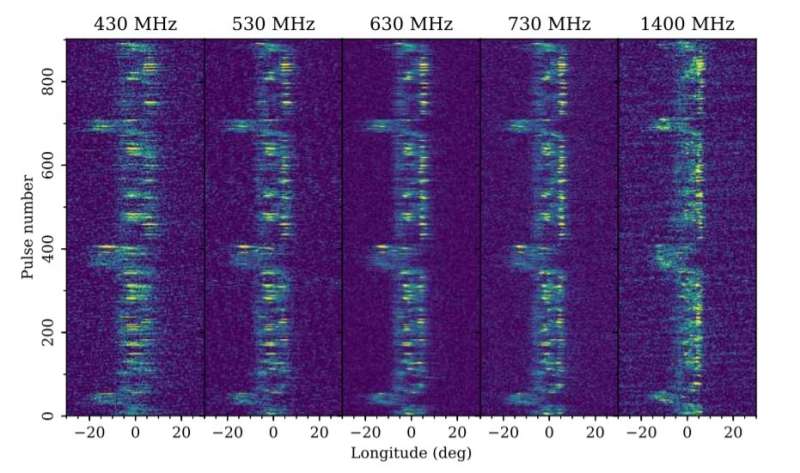The pulse-stack of PSR B1859+07 simultaneously observed with FAST using UWB receiver in February 2018. Credit: Wang et al., 2022.
Using the Five-hundred-meter Aperture Spherical radio Telescope (FAST), Chinese astronomers have investigated a peculiar emission phenomena exhibited by a pulsar known as PSR B1859+07. Results of the study, published January 18 on the arXiv pre-print repository, could shed light on abnormal emission modes observed in some pulsars.
Pulsars are highly magnetized, rotating neutron stars emitting a beam of electromagnetic radiation. They are usually detected in the form of short bursts of radio emission; however, some of them are also observed via optical, X-ray and gamma-ray telescopes.
Some pulsars showcase variability in emission ranging from extremely short bursts, like giant pulses, to long-term changes in their emission profiles. In some cases, mode-changing has been observed in which the emission profile switches between two or more quasi-stable modes of emission.
PSR B1859+07 has a spin period of 0.64 seconds and a relatively high dispersion measure of about 252.8 cm-3/pc. The pulsar is known to showcase abnormal emission phenomena in the form of shifts of emission to an early rotational phase and mode change of emission at the normal phase.
In order to investigate this peculiar behavior, a team of astronomers led by Lin Wang of the Key Laboratory of FAST, decided to perform broad-band radio observations of PSR B1859+07 using FAST at 0.4 GHz (with Ultra-Wideband receiver—UWB) and at 1.4GHz (with a 19-beam receiver).
In general, Wang's team managed to generate 22,769 individual pulses in total, and captured 124 emission shift events. The study confirmed the three emission modes exhibited by PSR B1859+07 that were suggested by previous observations, including the B (burst) and Q (quiet) modes of the non-shift pulses and the emission shift mode with a quasi-periodicity of 155 pulses.
"Our results show that all the three emission modes have similar PA distributions; thus, we suspect the emission at the same phase corresponds to similar emission height," the authors of the paper explained.
Moreover, the researchers integrated the pulses of the B and Q modes in each frequency band and generated average profiles of these two modes. They found that both profiles of the two modes exhibit complex components, and each component shows evolution with frequencies.
The study also identified a new type of emission shift events in PSR B1859+07 with emission at both the shift and non-shift phase. All in all, the astronomers assume that the unusual emission shift events observed from this source could be a result of the pulsar's emission beam asymmetry, the change of pulsar magnetosphere or dynamic effects around this object. However, further monitoring of PSR B1859+07 and other pulsars exhibiting similar emission phenomena, using high sensitivity telescopes, is required in order to draw final conclusions.
More information: Lin Wang et al, The unusual emission from PSR B1859+07 with FAST. arXiv:2201.06815v1 [astro-ph.HE], arxiv.org/abs/2201.06815
© 2022 Science X Network
























